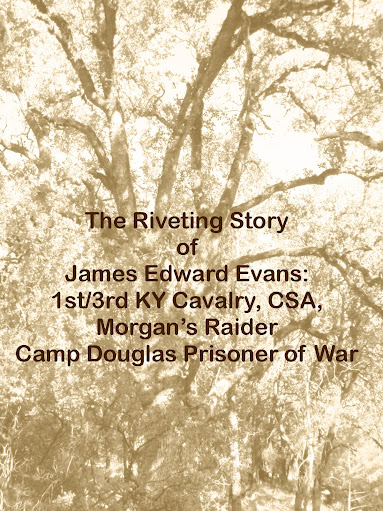Abatis: Form of defense usually made of fell trees sharpened at one end. The sharpened ends were placed facing the enemy.
Abolitionist: Person opposed to slavery and in favor of banning the practice in the United States.
Artillery: Cannon or other large caliber firearms; a branch of the army armed with cannon.
Battery: The basic unit of soldiers in an artillery regiment; similar to a company in an infantry regiment. Batteries included 6 cannon (with the horses, ammunition, and equipment needed to move and fire them), 155 men, a captain, 30 other officers, 2 buglers, 52 drivers, and 70 cannoneers. As the War dragged on, very few batteries fought at full strength. A battery can also be the position on a battlefield where cannon are located.
Bivouac: Passing the night without any shelter save what could be hastily made from plants, branches, and items such as the soldier’s coats. Morgan and his officers often slept in private homes and hotels leaving the men to sleep on the ground.
Breastwork: Low defensive barrier often make of earth and wood. Usually about breast high, it shielded defenders from enemy fire.
Brigade: An organized military unit generally composed of five regiments and led by a brigadier-general.
Bushwhacker: Man hidden in the bushes to act as a sniper. Many Indiana and Ohio citizens, as well as militiamen, took shots at Morgan’s Raiders as they past by.
Butternut: Slang used to refer to Southern Sympathizers. Confederate uniforms were dyed with plant material taken from the Butternut tree.
Cartel: A formal written agreement negotiated by nations at war. Although the United States never recognized the Confederacy as a nation, numerous cartels were executed between the two governments addressing such things as the treatment of wounded and prisoners of war and the exchange of letters and telegrams.
Cavalry: A branch of the military mounted on horseback. Cavalry units in the Civil War could move quickly from place to place or go on scouting expeditions on horseback, but usually fought on foot. Their main job was to gather information about enemy movements.
Company: The smallest unit in the organized army. Consisting of 50 to 100 men, a company was led by a captain and two lieutenants.
Copperheads: Slur used when referring to Northerners who opposed the Civil War and occasionally worked to undermine the war effort.
Debouch: to come forth from a narrow or shut-in place into open country
Division: Military unit composed of two to four brigades led by a major general.
Entrenchments: Long ditches dug with dirt piled up into a mound in front. They were used for defense.
Federal: Supporter of the United States Government during the Civil War; soldiers in the Union army; Northerner
Feint: An offensive move designed to deceive the opponent as to the location and/or time of an actual offensive action. This distraction ensured that the enemy would pull troops out of the main area of primary assault and commit manpower to a lesser area of attack. Morgan used this tactic was often.
Foraging: Roving the countryside in search of food; sometimes stealing food. Military rules often disallowed foraging but when allowed, strict rules were to be enforced. An officer was placed in charge to guard that soldiers not use threatening or abusive language, trespass in a private dwelling and leave enough for family subsistence. Too often, both Union and Confederate soldiers became marauders, answering to no one and gathered spoils of war as they pleased.
Frontal assault: A direct attack on the enemy’s front.
Garrison: A group of soldiers stationed at a military post.
Grayback: body lice
Greenback: Slang term for U. S. paper money which was printed using green ink.
Haversack: Small canvas sack used by soldiers to carry their personal belongings.
Infantry: Soldiers trained and equipped to fight and travel on foot.
Militia: Troops called out to defend an area in an emergency.
Minie ball: Large, elongated bullet made of soft lead. The bullet was designed for muzzle-loading rifle-muskets.
Parole of honor: A pledge by a prisoner of war or a defeated soldier not to bear arms usually given in exchange for release.
Partisan Ranger: Member of a Confederate sanctioned guerilla band. Their main mission was to distract Union forces. In addition to regular army wages, they received payment for confiscated horses, weapons, and other enemy supplies.
Picket: Soldiers posted on guard. Pickets usually included about 40 or 50 men. Several pickets would form line in front of the camp. In case of attack, the pickets would warn the rest of the force.
Quickstep: A fast rate of march, about 110 steps per minute, during which soldiers covered 85-90 yards; often associated with a “forced march” in which infantry were quickstepped to the point of exhaustion.
Regiment: Military unit composed of 10 companies and led by a colonel. Usually made up of 1,000 to 1,500 men, regiments were designated by state name and a number.
Rifled: A gun barrel is rifled when it has grooves cut into the inside of the barrel for longer range and more accurate firing. Morgan’s Parrot guns were rifled.
Sink: A large pit toilet.
Secesh: Northern slur used when referring to Confederates. The term was derived from the word secessionist.
Skedaddle: Slang term for retreat or for running away from battle.
Skirmish: A minor fight.
SNAFU: Military acronym usually translated as "Situation Normal: All F***ed Up".
States rights: The political belief that all powers not given to the central government by the Constitution belonged to the states.
Sutlers: Civilian businessmen, appointed by the Army to be camp vendors. Sutlers often inflated prices and extended credit thus making themselves wealthy. From these vendors a soldier could purchase such items as food, newspapers, books, tobacco, razors, tin plates, cups, cutlery, and illegal alcohol.
Vidette: Another term for picket. Videttes were usually found on horseback. Also spelled "vedette," the word derives from the Latin meaning to "watch" or "see."
Zouave: units known for their colorful uniforms and bravery.
Sources for this Glossary:
Faust, Patricia L."Historical Times Illustrated Encyclopedia of the Civil War."
Boatner, Mark M., III. "The Civil War Dictionary."
Subscribe to:
Post Comments (Atom)





No comments:
Post a Comment